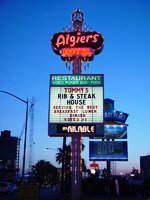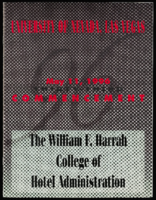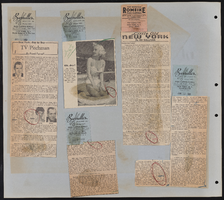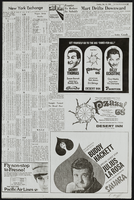Search the Special Collections and Archives Portal
Search Results
Valda and Esper Esau Collection on Lido de Paris
Identifier
Abstract
The Valda and Esper Esau Collection on Lido de Paris (1954-2014) mainly consists of newspaper clippings, ephemera, and programs documenting the career of entertainer Valda Esau, who danced in the
Archival Collection
Elmo and Charlotte Ellsworth Photograph Collection
Identifier
Abstract
The Elmo and Charlotte Ellsworth Photograph Collection (approximately 1940-1959) is comprised of black-and-white photographic prints and negatives. The images depict Charlotte and Elmo Ellsworth. Also included is an image of Elmo Ellsworth on horseback at the Las Vegas, Nevada airport for the arrival of the first United Airlines flight and an image of people at the Last Frontier Village in Las Vegas.
Archival Collection

Transcript of interview with Joel Bergman by Stefani Evans and Claytee D. White, August 03, 2016
Date
Archival Collection
Description
Born in 1936, architect Joel Bergman spent his childhood in Venice, California, the son of Edythe Klein and Harry Bergman, a baker who later turned to dealing in scrap metal. The award-winning designer of such Las Vegas projects as the International Hotel, the MGM Grand Hotel (later Bally's), additions to the Riviera Hotel and the Golden Nugget downtown, the Mirage, Treasure Island, Paris Casino Resort, Caesars Palace, Trump International Hotel and Tower, the Signature at MGM Grand, Rhumbar, Gilley's at Treasure Island, and the Tropicana Hotel and Casino first arrived in Las Vegas in 1968 to work on the International Hotel. In this interview, Bergman discusses his architectural career, which began with his graduation in architecture from the University of Southern California; he also discusses his work with Martin Stern, his sixteen years with Steve Wynn, and the formation of his own architectural firm, Bergman Walls and Associates. Throughout, he pays tribute to the three mentors who had the greatest influence on his work—USC architecture professor Carleton Winslow, architect Berton Severson, and client Steve Wynn—and the ways they visualized people moving through space. He acknowledges other professionals whose work he admired and talks about his wives Marlene Federman, Terrie Colston, Maria Nicolini, and Valentina Bogdanova as well as his children and stepchildren. Joel David Bergman passed away August 24, 2016, three weeks after he gave this interview.
Text

Photographs of Algiers signs, Las Vegas (Nev.), 2002
Date
Archival Collection
Description
Site name: Algiers Hotel (Las Vegas, Nev.)
Site address: 2845 S Las Vegas Blvd
Sign owner: Larry Kiefer
Sign details: Located on the NE corner of Riviera Blvd and Las Vegas Blvd The facade of the Algiers building itself is comprised of storefronts, while the hotel portion lies through an archway, behind the facade. The entire stucco front is illuminated and treated with neon borders and font. Across the narrow parking lot stands the Algiers pylon sign, along Las Vegas Blvd
Sign condition: Structure 3 Surface 3 Lighting 4
Sign form: Pylon; Fascia
Sign-specific description: The façade and pylon/pole sign work together to create the attraction of the Algiers. The pole sign is double backed sign with neon marquee logo at the top and an internally lit, white, plastic front, message board with vinyl lettering. The top section of the message board is a rear lit, plastic, graphically treated sign, while the bottom of the board is an electronic message center. Crowning the very top of the structure is a sculpted crown-shape comprised of the polished brass raceways, which also adorn the top and lower portions of the pylon. These raceways contain 11 watt white incandescent bulbs which chase each other from top to bottom. The Algiers logo is channel lettering with double neon of the rose colored variety. The word "Hotel" is spelled in ruby neon. The façade of the building is comprised of five different sections. The first contains the Algiers logo in channel letters filled with blinking incandescent bulbs and outlined in ruby neon. Texts " Hotel, Restroom, Video poker, pool and entrance," are spelled in rose colored neon. The next four sections are storefronts with neon borders in their windows. Each section is separated by a section of vertical, polished, gold raceways with chasing animated bulbs. The backlit graphically treated storefront marquees adorned with an incandescent bulb border. The last section of the building supports a metal sign box with double neon letters spelling "Algiers". Above each section, the storefront crowns to a point, reminiscent of a classic Persian gateway or spire. Each swooping section is bordered with vibrant neon.
Sign - type of display: Neon; Incandescent; Backlit
Sign - media: Steel; Plastic
Sign - non-neon treatments: Graphics; Paint
Sign animation: Chasing, flashing, oscillating
Notes: The text, which resides on the southern wall and reads "Casino," is filled with incandescent bulbs that all illuminate at the same time, and oscillate. They then shut off at the same time, and then repeat. The raceways of incandescent bulbs chase each other while the neon, which surrounds the back lit, plastic, screens on this wall flash on then off. The bottom two raceways sandwiching the reflective panel chase from left to right, while the remainder of the raceways surrounding the signs, run right to left. The incandescent bulbs on the pylon chase each other gracefully up the length of the pylon. The animation is patterned so as to appear as if a section of several bulbs are pulsing its way up the towers, hugging the edge of the bulbous tops. The raceways continue around the east face of the building. The umbrellas in the plaza behind the pylon, also are animated with incandescent bulbs chasing each other downward along the raceways.
Sign environment: The Algiers is settled across the street from the Circus Circus and shares the lot with the Candlelight Wedding Chapel.
Sign manufacturer: YESCO
Sign - date of installation: 1953
Sign - date of redesign/move: Refinished in 1992 by Larsen Sign
Sign - thematic influences: The Algiers is an Arabian nights/Persian theme, mixed with the vestiges of classic Vegas aesthetics, such as the polished, gold, animated raceways, the roadside pole sign design, the text, and the similarity to the classic desert paradise theme of the 50's through today. Examples of this classic style are the Sands, the Dunes, the Aladdin, and the Sahara.
Sign - artistic significance: As mentioned above it is a representation of an era in Vegas and the thematic influence of the desert themed establishment.
Surveyor: Joshua Cannaday
Survey - date completed: 2002
Sign keywords: Flashing; Oscillating; Chasing; Pylon; Fascia; Incandescent; Neon; Backlit; Steel; Plastic; Graphics; Paint; Pole sign
Mixed Content
Donn Arden Papers
Identifier
Abstract
The Donn Arden Papers (1910s-1990s) document Arden's sixty-plus years in the entertainment industry working in showrooms and nightclubs all over the world including Paris, France, Las Vegas, Nevada, New York, New York, and Los Angeles, California. Donn Arden worked as a choreographer, producer and director known for creating extravagant production shows that combined spectacular scenery and disaster with sequined and feathered showgirls. The collection is comprised of production notes, programs, photographs, posters, sheet music, correspondence, costume design sketches, press clippings, and magazine articles.
Archival Collection

Patrick P. Keenan interview, February 28, 1977: transcript
Date
Archival Collection
Description
On February 28th, 1977, collector Clyde C. Caldwell interviewed Patrick P. Keenan (born January 24th, 1905 in New York) at his house in Henderson, Nevada. Mr. Keenan discusses Las Vegas and Henderson in the 1950s. He also speaks about working on the Strip and the changes he has seen in Las Vegas over time.
Text

University of Nevada, Las Vegas (UNLV) William F. Harrah College of Hotel Administration 33rd commencement program
Date
Archival Collection
Description
Commencement program from University of Nevada, Las Vegas Commencement Programs and Graduation Lists (UA-00115).
Text



